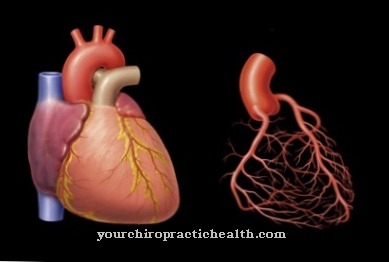The genetics is the doctrine of inheritance and deals with genetic information and its transmission. In genetics, both the structure and the functions of genes are examined in more detail. As an inheritance theory, it belongs to a branch of biology and examines individual characteristics that are passed on over several generations.
What is the genetics?

Johann Wolfgang von Goethe already dealt with the morphology of plants, among other things. He coined the word “genetic”, which at the time was still connected with embryology and romantic natural philosophy. The genetic method of the 19th century was the investigation of the ontogeny of organisms, i.e. their development as an individual or as an individual organism. The opposite of ontogeny was the development of the tribe, called phylogeny.
In fact, the word "genetic" eventually became genetics as the designated research discipline of the British geneticist William Bateson. That was in 1905 and it was he who coined the word. Genetics was hereditary biology and human genetics, which sadly established itself in Germany in 1940 when racial hygiene was called for.
Genetics and their specialization are therefore relatively modern and young. It was not until the 18th and 19th centuries that the first more intensive ideas about the natural process of inheritance emerged. The founder is the Augustinian monk and teacher Gregor Mendel, known for his cross-breeding experiments with flowers, plants and peas, which he evaluated and based on them developed the Mendelian rules named after him. He recognized a fundamental law in the inheritance of the disposition to the offspring. The rules established by Mendel established classical genetics, which in turn led to cytogenetics, including the discovery of the structure, number and shape of the chromosomes that acted as carriers of genetic information.
Mendel's rules only apply to organisms that are diploid and have haploid germ cells, which means that they have received a set of chromosomes from both parents. This is true of most plants and animals. Mendel used pea seeds and flowers, whose characteristics, color and shape he examined more closely. However, although he had recorded it forty years earlier, his findings were not recognized until 1900. Other biologists and botanists came to similar conclusions and discovered the chromosomes. Both theories and rules were combined and are now common property of genetics.
Of course, other genetic phenomena have been explored that deviate from Mendel's laws, e.g. B. gene linkage. Therefore, the rules according to Mendel have meanwhile become uncommon.
Treatments & therapies
The genetic makeup, also known as the genome, plays an essential role in genetics. This can affect both living beings and viruses. The genome is the totality of material carriers of all inherited information of a cell or a virus ‘. The DNA, chromosomes and RNA in viruses are researched. De Genetik is concerned with the structure of genomes and the interactions between genes. It is an essential part of genetics.
In humans, the genome consists of 46 chromosomes and 3 billion base pairs. The latter consist of around 80 percent undefined DNA and 20 percent gene-coding DNA. About 10 percent of this regulates the metabolism, 90 percent in turn are used for cell-specific gene expression. This, in turn, refers to the biosynthesis of proteins, which can be used to identify the genetic information and the processes it requires.
Molecular genetics is also an essential part of genetics, which was founded in 1940. This deals with the biosynthesis, structure and functions of DNA and RNA, the latter at the molecular level. She also observes how these interact with proteins and how they behave with one another.
The branch of genetics encompasses many fields, including not only genetics, but also biochemistry or biology. Here the molecular basis of inheritance play an essential role, the replication of the DNA in a cell or the macromolecules and their changes in the information content, which then z. B. can occur as a mutation. During replication, for example, there is always exact duplication of the DNA and it only occurs in a very special phase of the cell cycle. Cellular and genetic duplication leads to an increase in bacteria and primordial bacteria. The enzymes and raw materials of the host cell are used for the RNA of the viruses.
Another area of genetics is epigenetics, which deals with the transmission of the properties of all offspring that do not show any deviations in the DNA sequence, but changes in the gene regulation.
Diagnosis & examination methods
Whether z. B. Nicotine or alcohol addiction is inherited, is also part of genetics. Since the genetic make-up and their genetic material have a significant impact on the offspring, the genetic material including structure, function and characteristics is encoded, diseases occur again and again, the cause of which is to be found in a change in the DNA. Hereditary diseases are referred to here, which mostly do not occur in childhood, but rather in adulthood.
The DNA is mainly located in the cell nucleus. As soon as the genome shows defects, the genetic processes in the cells are disrupted. Cystic fibrosis or Down syndrome, for example, are two of the diseases that can occur due to an altered genetic makeup. These changes are passed on to the next generation either through the father's sperm or the mother's egg cell, and do not always have to occur in the following generation, but can also skip generations.




.jpg)









.jpg)













